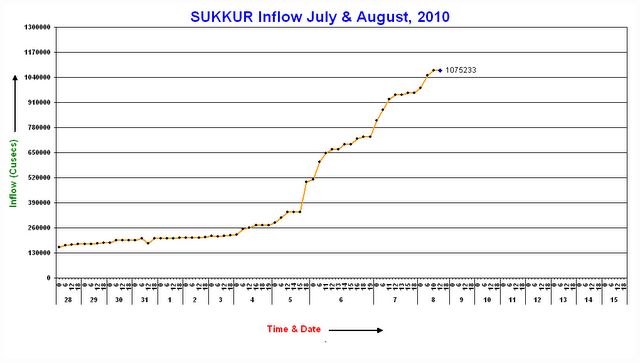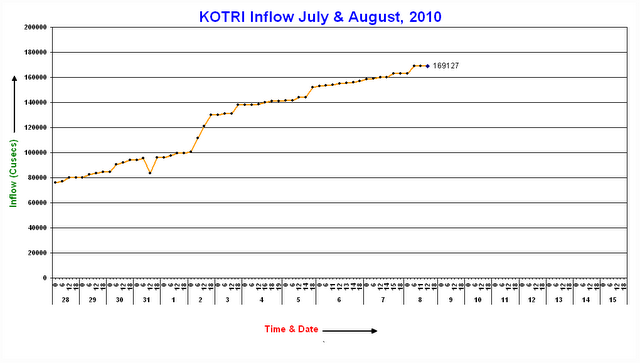8 August 2010
Update on the Pakistan floods: 8th August 2010
Posted by Dave Petley
The Indus flood wave is continuing to flow steadily southwards across the country. The annotated WHO flood map below, from my earlier post, is for reference in terms of the locations of the hydrograph stations:
The Pakmet hydrograph data shows that the water level at Taunsa is now declining markedly, although it remains in the defined “high” flood category:
Downstream at Guddu, the discharge has been rising, although it should now be close to the peak level:
Downstream at Sukkur, which is the area that is attracting most of the media interest at present, the discharge has been increasing very rapidly:
The barrage here apparently has a design capacity of 900,000 cubic feet per second, which is clearly a concern, although it is likely that it will survive the flood. Other agencies have suggested that the design flood is as high as 1.5 million cubic feet per second. It is however reported that a 25 m wide breach occurred in a levee at Kandhkot, about 70 km upstream of Sukkur. Other levees are showing signs of distress, and one levee (at Ghouspur) has been intentionally breached to try to reduce the size of the flood wave.
The final station downstream is at Kotri. Here water levels have yet to start to rise rapidly. The peak of the flood wave is expected to arrive in two or three days from now:
Meanwhile, the official weather forecast states “widespread rain-thundershower, heavy at times, expected in Punjab, Sindh, Eastern Balochistan, Khyber-Pakhtunkhwa and Kashmir.”
The impact of these floods on the long term welfare of the people of Pakistan should not be under-estimated. The combination of loss of life, loss of personal assets, loss of dwellings, loss of crop, damage to infrastructure, loss of sanitation and loss of clean drinking water across such a large area cannot be underestimated. That aid agencies are describing this as being worse than the 2005 earthquake, which is thought to have killed 100,000 people, gives an idea of the scale of the catastrophe. I would also note that, given the troubled history of this area, there is a very real opportunity for Europe and the US to be seen to be a force for good by providing a proper and effective response to the disaster. This would surely be a good investment for the future of both Pakistan and the west.







 Dave Petley is the Vice-Chancellor of the University of Hull in the United Kingdom. His blog provides commentary and analysis of landslide events occurring worldwide, including the landslides themselves, latest research, and conferences and meetings.
Dave Petley is the Vice-Chancellor of the University of Hull in the United Kingdom. His blog provides commentary and analysis of landslide events occurring worldwide, including the landslides themselves, latest research, and conferences and meetings.